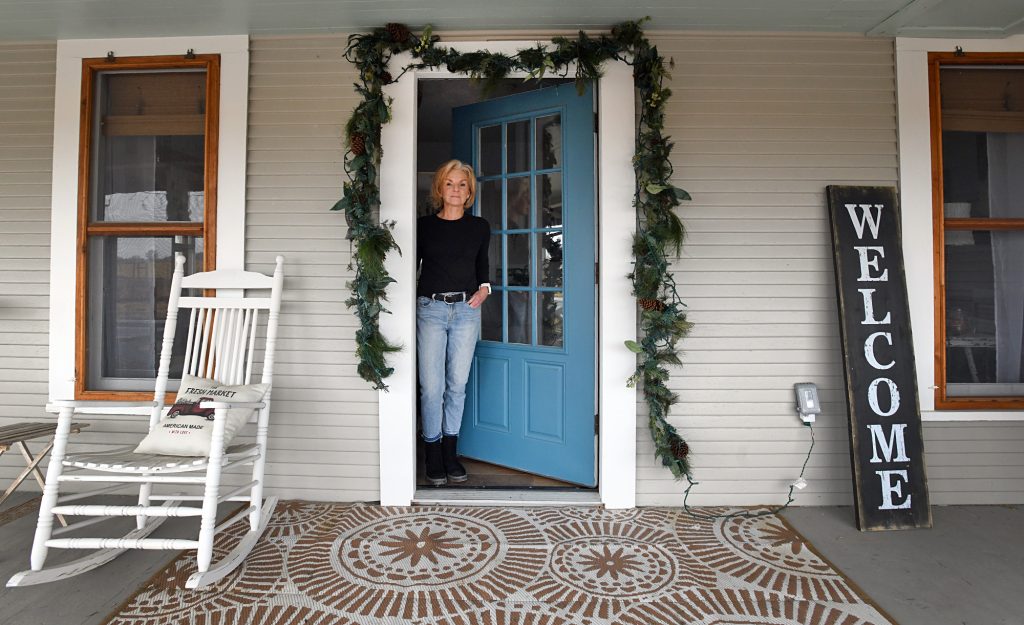Nonrenewals are fueling Colorado’s growing homeowners insurance crisis – The Colorado Sun

Karen Murray Boston and her husband Richard have spent several years restoring the 1918 house outside of Fruita that they bought four years ago when they moved to the Grand Valley from the Front Range. Murray Boston said that she recently called her American National insurance agent to find out what what their next year's homeowners policy premium was going to cost, as their premium had doubled from 2023 to 2024. That was when she discovered that their insurance was going to be terminated due to the fact that American National was no longer going to offer homeowners insurance in Colorado. (Gretel Daugherty/Special to the Colorado Sun)
The Colorado Sun
Telling stories that matter in a dynamic, evolving state. Editor’s Picks: Canadian wolves arrive in Colorado | Good news, bad news in teacher survey | Colorado women embracing huntingStory first appeared in:Karen Murray Boston had been looking forward to December for months so she could start shopping around for new homeowners insurance for her 1918 farmhouse in Fruita. But it’s not like she wanted to switch companies. Her insurer, American National Group, is dropping her this month and abandoning Colorado altogether. She found out only after calling her local agent in September to see if her annual premiums were increasing again, as they did in 2024, doubling to $2,000. “And when I called, I got the office manager on the phone and I said, ‘I want to talk about our insurance for next year. Are we going to see our rates go up again?’” Boston said. “And she goes, ‘Well, you’re on the list to be canceled,’ and I went, I think I screamed, ‘What?’ She goes, ‘Yeah, you didn’t get a note yet?’ I said, ‘No, I didn’t get a note.’”The cost of property insurance in Colorado has become one of the fastest-growing household expenses, with premiums increasing an average of 57.9% from 2018 to 2023, according to the Rocky Mountain Insurance Association. Hail storm damage may be largely to blame in Colorado but as wildfires rage in Los Angeles, there’s a growing concern of the impact on insurance premiums thousands of miles away. But even more troubling for homeowners is the possibility of getting a cancellation or nonrenewal notice, or prospective homebuyers hunting for a house in areas deemed too risky by insurers. How bad is it for Coloradans? We’ve dug through the data and talked to experts to explain what has happened, why insurance has become so expensive and what the state is doing about it. After months of anxiety, Boston finally found a new insurer on the Western Slope to cover her home. She had to wait to shop around until there was just a month left on her policy because quotes are only good for 30 days. The cost was lower than her old policy, but she doesn’t think that’s typical based on what she’s hearing from friends.“I have not heard that people are losing their insurance … but I have heard the stories of significant increases. What are we going to have to pay now?” she said. “You wonder if people out there who don’t have a mortgage and are not required to have (insurance) will even choose to have homeowners insurance. What are those consequences?”While Colorado’s Division of Insurance said it hasn’t heard of insurers other than American National leaving the state, there’s certainly a trend of policies being canceled in some communities with a higher risk of wildfires. That’s why Colorado is rolling out its own insurance for homeowners who can’t get coverage elsewhere.Karen Murray Boston holds up paperwork sent to her by American National Insurance with whom she and her husband Richard have their homeowners policy on their 1918 Fruita home informing them that the company was terminating their insurance as it would no longer insure homes in Colorado. (Gretel Daugherty, Special to the Colorado Sun)“We haven’t had companies wholesale leave, but we’ve had companies that have made underwriting changes” to areas where policies are offered, Colorado Insurance Commissioner Michael Conway said. “And because of that, we started to see little pockets of the state where consumers are having a hard time finding coverage.”He mentioned Evergreen and Conifer, some of the closest mountain towns to the Front Range.Last month, the U.S. Senate Budget committee released a report on the trend of insurance companies declining to renew homeowners’ policies, especially for those living in hurricane- or wildfire-prone coastal states of Florida, Louisiana, California and Texas. The report also pointed to severe weather trends in noncoastal states like Colorado, which had a higher nonrenewal rate than Texas last year. Colorado had the nation’s sixth highest nonrenewal rate in 2018 but fell to the middle of the pack five years later, overtaken by southern states and California. That’s likely due to the whims of the weather in Colorado, which is part of “Hail Alley,” so named because the area where Colorado, Nebraska and Wyoming meet averages a high number of hail storms a year, according to the National Oceanic and Atmospheric Administration’s National Severe Storms Laboratory. But overall nationwide, the majority of states saw their nonrenewal rates increase more than 25%, with some up nearly 300% since 2018, according to the Senate report. “As climate change gets worse, so does trouble in insurance markets, threatening mortgage markets and property values. In certain communities, sky-high insurance premiums and unavailable coverage will make it nearly impossible for anyone who cannot buy a house in cash to get a mortgage and buy a home. Property values will eventually fall — just like in 2008 — sending household wealth tumbling,” the report concluded.The insurance industry pushed back on climate as the prime factor in nonrenewals. While extreme weather is a growing cause, industry officials point to inflation and regulations that have also raised the cost of rebuilding a home, while an increase in insurance fraud and litigation are exacerbating insurer losses.In eight of the past 11 years, property insurers have lost money in Colorado, said Ethan Aumann, senior director of environmental issues and resiliency at the American Property Casualty Insurance Association.Between 2013 and 2022, “Colorado homeowners insurers had an underwriting loss of 18.6%,” Aumann said, “so another way to think about that is that for every dollar of premium that insurers have earned, claims and expense costs were actually $1.18. We’re expecting the final data for 2023 to be another big loss there.”That report won’t be out until spring but the Colorado Division of Insurance’s annual report already shows that homeowners insurers had a loss in 2023.It was a doozy of a year for hail, according to the Colorado Climate Center at Colorado State University. There were nearly 800 reports of 1-inch-sized hail or larger, besting the old record of 561 set in 2018. In 2023, there were 796 reports of 1-inch hail, breaking a previous record of 561 in 2018, according to a report by the Colorado Climate Center at Colorado State University. There were 176 reports of 2-inch hail (compared with the previous high of 91 in 2018), 37 reports of 3-inch hail (compared with 12 in 2019) and five reports of 4-inch hail (compared with five in 2005). Hail storms up and down the Front Range from 2017 to 2019 caused so much damage to roofs and buildings that several events landed in the the Billion-Dollar Weather and Climate Disaster project over at NOAA’s National Centers for Environmental Information. “Everybody focuses on wildfire,” Conway said. “But the affordability problems we have in Colorado are driven by hail. Anywhere from 50% to 60% of the insurance premiums that people pay in Colorado is, on average, paying for hail.”In 2023, Coloradans paid a record $4.5 billion in homeowners insurance premiums, as seen in the chart below.Conway is also preparing for a potential fallout similar to what has happened in states like Florida and California, where well-known insurers like State Farm, Farmers and Allstate have paused new business. They blamed wildfires, inflation and reinsurance, the Los Angeles Times reported. After the wildfires erupted in Los Angeles this month, California expanded a moratorium preventing insurers from ending coverage for properties in the area.In Colorado, the vast majority of Colorado homeowners can still get insurance, said Carole Walker, executive director of the Rocky Mountain Insurance Association, which represents insurers.“From a statewide perspective, there isn’t an availability crisis,” Walker said. “We’re seeing premiums rise, but at the same time, people are still able to get insurance and to get mortgages and stay in their homes. It really is just an adjustment to that new normal of higher insurance premiums and looking for solutions to those pockets of availability.”But there is concern the same thing that has happened in California could happen in Colorado, which is why the state is launching its own homeowners insurance product this spring. The Fair Access to Insurance Requirements, aka the FAIR Plan, is called the insurance of last resort. It’s for homeowners who are turned down by at least three insurers. Prices are expected to be higher than standard insurance.LEFT: Water rushes down Cherry Creek and covers the adjoining bicycle path as heavy rains fall across the metropolitan area on May 11, 2023, in Denver. RIGHT: Flames rise amid the billowing smoke from a wildland fire burning along the ridges near the Ken Caryl Ranch development on July 31, 2024, southwest of Littleton. (AP Photo/David Zalubowski)Last fall, Conway and other insurance officials traveled around the state to host town halls. They talked about the high cost of insurance and listened to residents. They heard horror stories.One man attending the October session in Louisville said his small eight-unit homeowners association in Denver faced a 275% premium hike and higher deductibles. He took $25,000 from his retirement savings to cover the gap for the HOA. Neighbors paid him back, but some decided to sell their homes because they could no longer afford them. A woman from Estes Park said her HOA hadn’t had an insurance claim in 10 years. But as property values increased, so did their estimated replacement costs and their premiums soared. Then their insurer, American Family Insurance, pulled out of the local condo market. Grasping for new coverage — and turning down a secondary provider who offered a 619% premium increase — they opted for a bare-bones policy from State Farm covering just the structure. Unit owners had to get additional coverage for their stuff.Similar stories abound. The cause is often explained as the convergence of multiple factors. More people are living in more expensive housing so when a destructive hailstorm or other extreme weather event hits, damage is more costly than ever before. Between 1982 and 2024, Colorado had 75 weather-related disasters where losses exceeded $1 billion, according to NOAA’s billion-dollar disaster list. Two-thirds of the tracked disasters have occurred since 2010. In the past 10 years, hailstorms have caused more than $5 billion in insured damage in Colorado, according to Rocky Mountain Insurance Information Association. Last year, two hail storms in Yuma and metro Denver resulted in $1 billion in damages, according to NOAA.“It’s just going to get more expensive until we find ways to start to control those losses,” Conway said during a town hall meeting in Pueblo in October.NOAA only tracks events where losses were $1 billion or more, so not all Colorado disasters made the list. Some, like the Marshall fire in Boulder County in late 2021, are lumped into multistate disaster accounting. The wildfire destroyed more than 1,000 homes and structures and caused $2 billion in damage and was included in the $12.1 billion “Western Wildfires 2021” triggered by drought conditions and extreme heat. “Yes, it is likely that events missed the current cut and are not included in our current analysis,” Adam Smith, an applied climatologist at the Climate Science and Services Division of the National Centers for Environmental Information, said in an email. “We are now working on adding disaster costs for events down to $100M (1980-present) for all states.”Since 2010, the cost of living has risen significantly, up 55.4%, according to the consumer price index for the Denver metro area. Pull out housing-related inflation and the increases are much higher:As for insurance, an apples-to-apples comparison is challenging because property insurance isn’t tracked by the Denver-area consumer price index. But two reports show that property insurance premiums in Colorado have risen much higher than inflation. A state Division of Insurance report said the average home insurance premium grew 51.7% between January 2019 and October 2022. In the same period, eating out in Denver became 25.4% more expensive, while buying a new car increased 17% and overall, prices rose 18.7%, according to CPI.In a report for the National Bureau of Economic Research, University of Pennsylvania professor Benjamin J. Keys and Wisconsin School of Business professor Philip Mulder looked at the change in median premiums between 2020 and 2023 based on mortgage escrow payment data. In Colorado, the median homeowner’s premium grew 42.1% between 2020 and 2023. Inflation in the Denver area for the same period was up 16.8%. “Insurance is a lagging indicator. It takes really a year or two to even identify inflation, document what’s happening and then if you file new rate requests, there’s a wait period of about six to 12 months,” said Aumann, with the American Property Casualty Insurance Association. “The insurance industry has been playing a bit of catch-up with this period of rising losses and natural disasters. We’re not saying that climate change isn’t a factor. It’s just one element of these cascading impacts that are amplifying losses.”More people have moved to Colorado, too, especially along the Front Range, which as mentioned, is part of the notorious Hail Alley. The same hail storms of yesteryear are now smacking many more houses than in the past. In this pie chart from the state demographer, here’s where people have moved to in Colorado since 1870.Rural counties make up a smaller share of the population, but their population has increased, too. Insurance costs have risen higher there than on the Front Range. From 2020 to 2023, the median cost of premiums jumped 102.8% in the sparsely populated Conejos County, 80% in Grand County and 74.8% in Rio Grande County, according to the mortgage analysis by Keys and Mulder. Denver’s rates were up 38% in the same period.About a dozen counties had limited or incomplete data due to too few responses, including Crowley County. But the data showed that the median insurance premium paid in Crowley County — one of Colorado’s poorest — was $2,563 in 2023.One year after purchasing her home in Crowley County in 2021, Sue Breininger said her homeowner’s insurance premium jumped to $3,000 from $1,200 for her 1,865-square-foot, ranch-style home. She switched to Allstate, which was offering a slightly lower rate at $2,800, but was quickly canceled and given a 60-day window to fix her siding and make other repairs to her shed to make her place fit to insure. This story first appeared in Colorado Sunday, a premium magazine newsletter for members. Experience the best in Colorado news at a slower pace, with thoughtful articles, unique adventures and a reading list that’s a perfect fit for a Sunday morning.“It’s really, really hard to find someone in this area to do the work, and the person who promised me that he was going to do it flaked out at the last minute, so I missed that 60-day deadline,” she said.Now, Breininger is back with Safeco and paying $2,200 a year, which is still a 45% increase from three years ago. “It could go up again,” she said. “I don’t know, I’m scared to death.” Also rising among rural households: nonrenewal rates, according to the Senate budget study.In looking at counties with at least 10,000 homeowners policyholders, Eagle County ranked 56th for highest in the U.S. for nonrenewal rate change. The county had 211 nonrenewals last year, for a rate of 1.84% of the 11,485 policies. That’s up from 71 policies that weren’t renewed in 2018, or a rate of 0.70% of the county’s 10,134 policyholders.Here’s the nonrenewal rate for all Colorado counties between 2018 and 2023. We’ve highlighted the Front Range counties in yellow so you can see how the more recent higher rates are largely focused on rural communities:COMING MONDAY: What’s next for homeowners insurance in Colorado? Come back tomorrow for what’s next for homeowners insurance in Colorado.Based on factual reporting, although it incorporates the expertise of the journalist and may offer interpretations and conclusions.
Tamara Chuang writes about Colorado business and the local economy for The Colorado Sun, which she cofounded in 2018 with a mission to make sure quality local journalism is a sustainable business. Her focus on the economy during the pandemic…
More by Tamara Chuang
Olivia Prentzel covers breaking news and a wide range of other important issues impacting Coloradans for The Colorado Sun, where she has been a staff writer since 2021. At The Sun, she has covered wildfires, criminal justice, the environment,…
More by Olivia Prentzel
The Colorado Sun is an award-winning news outlet based in Denver that strives to cover all of Colorado so that our state — our community — can better understand itself. The Colorado Sun is a 501(c)(3) nonprofit organization. EIN: 36-5082144(720) 263-2338Got a story tip? Drop us a note at tips@coloradosun.com
Source: http://coloradosun.com/2025/01/19/colorado-home-insurance-nonrenewals-crisis/






